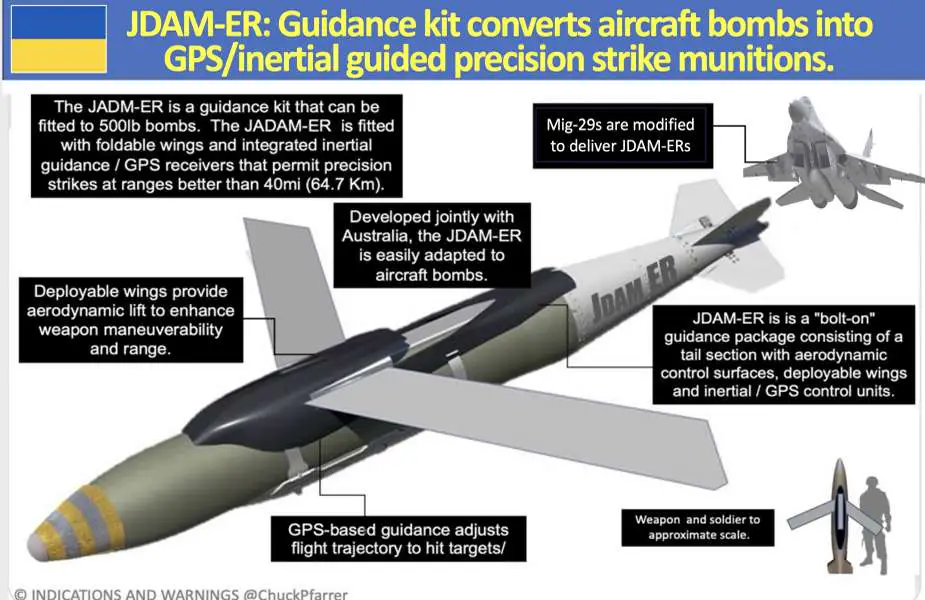The announcement on social media by the Ukrainian Air Force about the destruction of a command post and a missile artillery depot of the Russian forces near a military base in the Kherson region, using a JDAM-ER guided bomb, is an interesting event. The JDAM-ER (Joint Direct Attack Munition-Extended Range) represents an advancement in guided munition technology, offering military forces the capability to precisely strike targets at a significantly increased distance compared to earlier versions of the JDAM. A series of strikes were recently conducted by Ukrainian forces against Russian air forces, but with what objective? Perhaps to pave the way for the F-16 fighter jets.
Follow Army Recognition on Google News at this link

Ukrainian Air Force announced the destruction of a command post and a missile artillery depot of the Russian forces. (Picture source: Social Media)
This operation took place near Chelburda, in the Kherson region, a location that has been the scene of fierce fighting and strategic operations since the beginning of the conflict between Ukraine and the occupying forces. The use of the JDAM-ER by the Ukrainian Air Force illustrates the evolution of warfare in terms of military technology and the increasing competence of Ukrainian forces in utilizing such advanced technologies.
The JDAM-ER is an evolution of air-to-ground guided bombs, designed and developed by the United States. This munition is characterized by its ability to convert unguided bombs into high-precision guided weapons, using a guidance system that combines GPS (Global Positioning System) and INS (Inertial Navigation System). This technology enables the JDAM-ER to achieve a specified accuracy of 13 meters, although its realized accuracy is around 7 meters in practice.
The JDAM-ER is in service in 37 countries worldwide, available in several variants such as the GBU-31 (v) 1/B, GBU-31 (v) 3/B, GBU-32 (v) 1/B, and GBU-38, with launch weights ranging from 253.6 kg for the GBU-38 to 961.4 kg for the GBU-31 (v) 3/B.
The JDAM-ER can operate at altitudes up to 13,677 meters (over 45,000 feet), allowing it to be dropped far from enemy anti-aircraft defenses, thus reducing the risk to the launching aircraft. Its maximum range of up to 24.14 kilometers (15 miles) is made possible by adding wings on certain variants, such as the GBU-31, GBU-32, and GBU-38, whose wingspans vary from 35.6 cm to 63.5 cm. These wings significantly increase the distance over which the bomb can glide toward its target after being dropped, thereby increasing its effective range compared to earlier versions of JDAM without wing extensions.
The dimensions of the bombs also vary, with lengths ranging from 235.2 cm for the GBU-38 to 387.9 cm for the GBU-31 (v) 1/B. This range of sizes and weights allows military forces to tailor their arsenal to the specific mission, whether for precision strikes against high-value targets or attacks on larger enemy installations.
Recently, Ukrainian forces have conducted a series of strikes specifically targeting Russian air forces, and the cases of Russian aerial vehicle destruction are countless. This attack is ultimately just one among many, but the question arises: what objective are the Ukrainian forces aiming for by increasing their strikes? A parallel can be drawn with the arrival of the F-16s, which will not come by road. All these recent strikes may be preparing the ground for the Ukrainian F-16s. (JDAM-ER technical drawing source Chuck Pfarrer Twitter Account)
 Explication of the JDAM-ER used by the Ukrainian forces. ( Picture source: Chuck Pfarrer)
Explication of the JDAM-ER used by the Ukrainian forces. ( Picture source: Chuck Pfarrer)
















